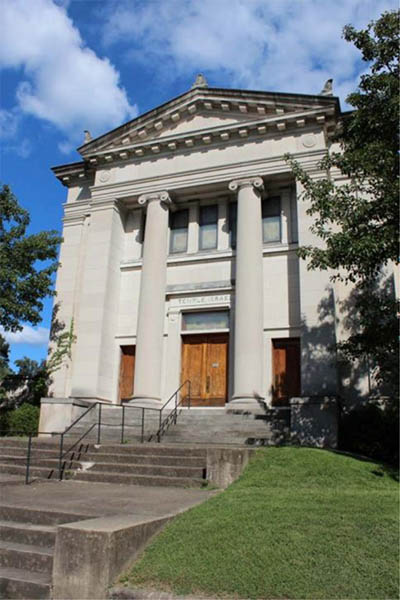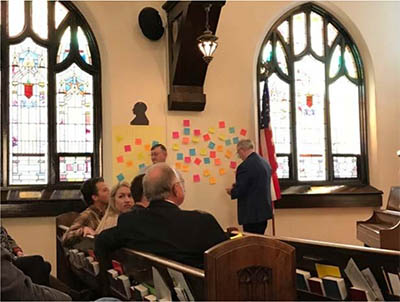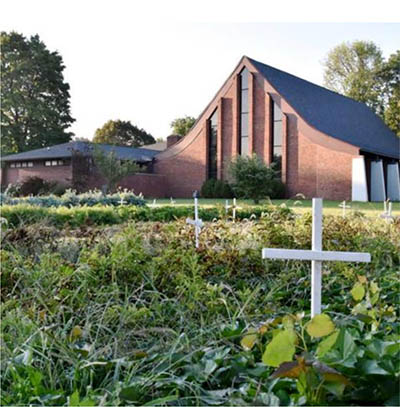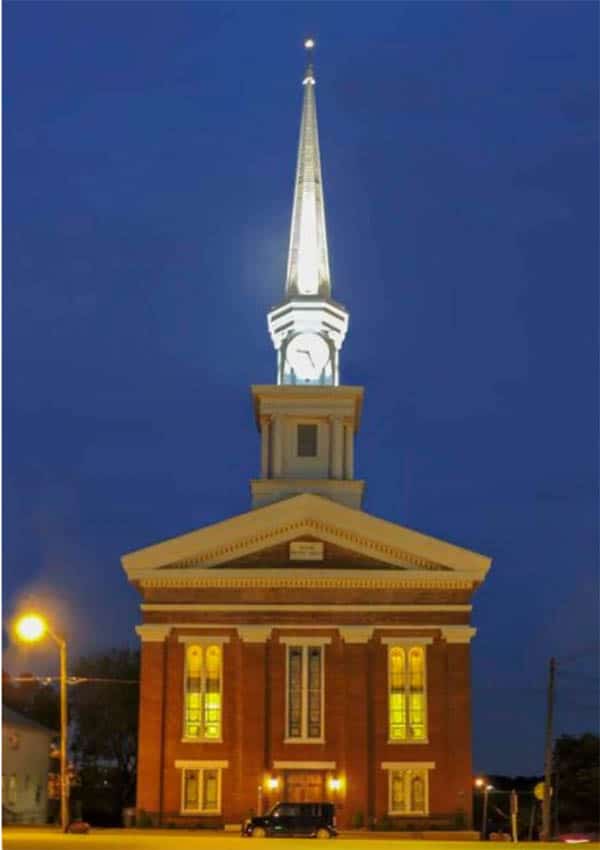Indiana is known for its thriving capital, Indianapolis, and cities such as Evansville and Fort Wayne that are dotted with spires and domes that signal the presence of active congregations in distinctive, important buildings. In addition, much of the state is known for its small towns, scattered among rich farmlands and, further south, rolling hills that approach the Ohio River. Like much of the Midwest and Northeast, many communities have declined in population over the years, and smaller churches are learning how to sustain their congregations and carry out their outreach with fewer resources.

United Hebrew Temple, Terre Haute, Indiana
Photo: Indiana Landmarks
At the same time, many of these churches have enormous assets: active leaders, a reputation for service and outreach, and historic buildings that have great cultural and architectural value that truly anchor their downtowns and main streets.
For the last four years, a strong statewide historic preservation organization—Indiana Landmarks—has been serving congregations in both small towns and larger cities, providing them with the tools and resources they need to repair their buildings and use their assets in creative ways to serve the larger community. In a very short time, Landmarks’ program—Sacred Places Indiana (SPI)—has become one of the most important and influential programs serving religious properties in America.
Landmarks is responding to what it sees as an urgent, growing issue in historic preservation. As its President, Marsh Davis, puts it, “Sacred Places Indiana is playing an important role in elevating the challenge posed by vacant and endangered religious buildings regionally and nationally.” He notes that his organization owns several vacant churches, and has restored a large and important church—the former Central Avenue United Methodist Church—for its headquarters in Indianapolis, so Landmarks knows this challenge well.
With two major grants from Lilly Endowment, Inc., Landmarks has served dozens of sacred places across the state, including 29 that have participated in the year-long New Dollars/New Partners program and qualify for planning and capital grants for their buildings. The director of SPI—David Frederick—has worked with churches from 42 counties to date, spreading the word and providing advice and resources across Indiana. He is, in effect, serving as the Johnny Appleseed for the state’s historic churches, encouraging congregations to see new ways to maximize the value of their buildings.

Asset-mapping in the sanctuary of First Presbyterian Church, Brazil, Indiana
Photo: Jeff DuellPeace
Frederick was an early pioneer in serving historic sacred places, first in his capacity as director of the Indianapolis office of Landmarks in the early 1990s, when he planned and managed educational workshops for congregations. After working in other sectors for years, he returned to Landmarks in 2015 to manage SPI.
The core of SPI’s work is New Dollars/New Partners for Your Sacred Place, a training program developed by Partners for Sacred Places that builds the capacity of up to ten congregations each year, followed up with grants to plan and execute important repair and restoration projects. Teams of leaders from each congregation gather four times during the year to learn how to articulate their larger civic value to neighbors and local leaders, develop new programs by connecting their building assets with assets in the larger community, and prepare for a capital campaign.
To supplement the training, Frederick visits each church, sometimes several times, to help them think about ways to connect their building assets to organizations and programs in the community, plan their capital projects, and extend and diversify their fundraising.
Frederick has noted again and again that his program can “lift the curtain” for congregations, helping them see the larger possibilities for activating church spaces and working with the larger community to serve people in need. Some of the congregations that really embraced the asset-mapping approach have gone furthest with SPI’s resources, such as United Hebrew Congregation in Terre Haute, which developed an interfaith program that has included the Jewish, Christian and Muslim communities. St. Alban’s Episcopal Church in Indianapolis saw its community gardening program as an asset that could grow; the parish invested in the program to generate a multi-fold increase in produce that was given to families in need. Program growth, in turn, attracted neighbors to join the parish.

Peace Garden at St. Alban’s Episcopal Church, Indianapolis
Photo: Debbie Dehler
SPI has also helped churches plan and carry out their repair projects, such as St. Athanasius in Indianapolis, which struggled to find a contractor to carry out the repair of its large stained glass window on the west facade. Thanks to SPI, the parish found a contractor that was able to take on the job.
SPI’s grants have leveraged major projects, such as the creation of better kitchen facilities for food and hunger programs sponsored by Second Baptist Church in New Albany. Wabash Presbyterian Church is embarking on a major project to replace its roof and boiler, and has been supported in its work to plan a large, six-figure capital campaign.
Bethel Community Church in Seymour was inspired to go out and knock on the doors of 1,000 households in town, attracting new volunteers as well as foundation grants to support their outreach programs. The Rev. Dr. Sondra Gentry, pastor of Bethel, sums up the program’s impact: “Sacred Places Indiana’s work has inspired conversations with strangers, the development of relationships with community leaders and organizations, identified funding, and inspired donors.”
To encourage ongoing learning and mutual support among congregations, one of Frederick’s goals is to create an alumni group of leaders who have participated in New Dollars in years past. He has other ambitions as well: “Sacred Places Indiana has new opportunities to encourage churches to use their space better, and help them nurture a culture of giving that can serve as a solid foundation for capital campaigns and community-wide fundraising.”
Marsh Davis is delighted that SPI is now an integral part of Landmarks’ work. He is eager to add new dimensions to the strong relationship between Landmarks and Partners, and find creative new ways to ensure that sacred places—and their community value—are appreciated and preserved for generations to come.

